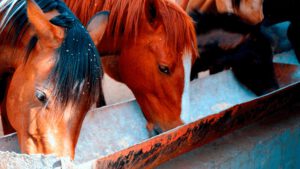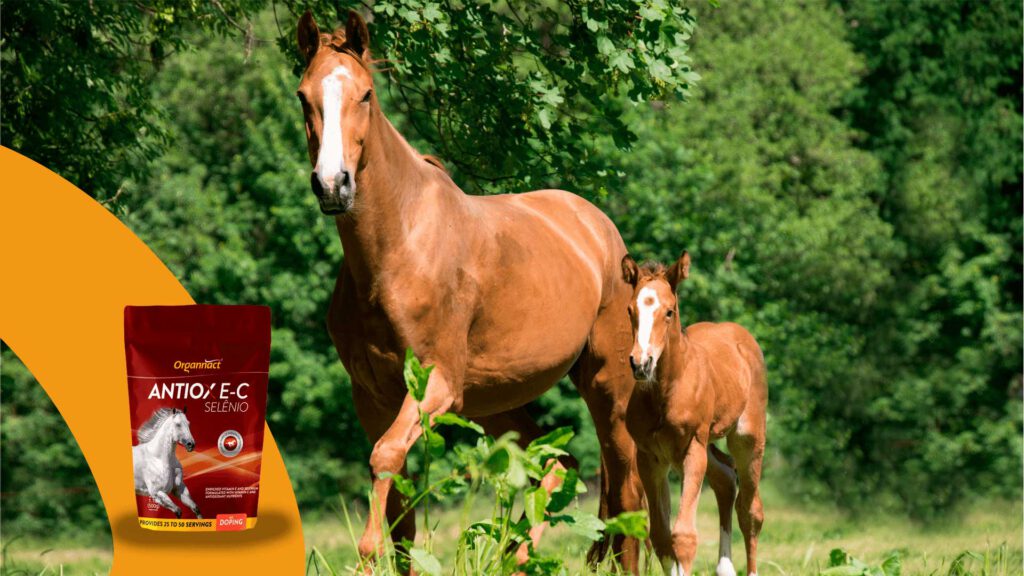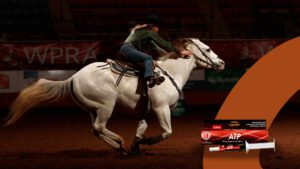
- +1 (469) 975-1465
- contact@organnact.com
- 11401 NW 134th St, Medley, FL 33178, EUA

Horses engaged in intense workout routines, such as athletic horses, are predisposed to oxidative stress. This condition arises from an imbalance between oxidative and antioxidative systems, potentially causing injuries to muscle fibers and genetic material, as well as muscular fatigue.
To ensure a healthier life for your horse, it’s essential to understand what oxidative stress is, how it works, and the main ways to prevent it. Continue with us in this following article to learn more!
During cellular respiration, not all oxygen that reaches the cell is converted into CO₂ and H₂O. As a result, oxidation of these cells begins, producing reactive oxygen species (ROS), also known as free radicals.
Although ROS are normally generated during cellular processes, their production can increase under certain conditions. Such as diseases, pregnancy, stress, and aging. This particularly occurs when horses are under intensive workout routines or participating in competitions.
Oxidative stress occurs when there is greater production of ROS than the capacity to neutralize or eliminate them. This imbalance can result from excessive production or failures in the neutralization systems of these molecules.
In a healthy organism, it’s vital to maintain a balance between the production and elimination of ROS, as they can interact with proteins, lipids, and nucleic acids, causing damage to cellular structures.
There are some mechanisms to eliminate reactive oxygen species (ROS), preventing oxidative stress. These mechanisms can be divided into two components: the endogenous and exogenous antioxidant systems.
The endogenous antioxidant system consists of enzymatic and non-enzymatic components. The enzymatic system includes enzymes such as superoxide dismutase, catalase, and glutathione peroxidase. While the non-enzymatic system comprises antioxidants like glutathione, myoglobin, ferritin, metalloproteins, coenzyme Q10, polyamines, melatonin, transferrin, and ceruloplasmin.
Exogenous antioxidants are substances found in the diet, such as carotenoids, vitamin E, and vitamin C. Supplementation can significantly improve these antioxidant capacities, helping to reduce damage caused by ROS.
For example, vitamin E is one of the most commonly included ingredients in equine supplements because it is the only antioxidant capable of interrupting the chain reaction of lipid peroxidation.
Other antioxidants that support the prevention of oxidative stress in horses include:
Incorporating antioxidants into horse’s diets is crucial for maintaining their health and performance. Antioxidants play a critical role in neutralizing ROS, preventing cellular damage that can compromise muscle health, aiding in post-exercise recovery, and contributing to the overall well-being of horses.
During periods of high metabolic demand, such as competition season, relying on a complete and high-quality supplement is fundamental.
Organnact Antiox E-C Selenium is a supplement that combines the action of three powerful antioxidants to not only prevent oxidative stress in horses but also to extend their longevity and optimize their performance.
We are one of the largest veterinary laboratories in Brazil. With over 30 years of experience, robust infrastructure, and cutting-edge technology, we expertly cater to the market’s needs with a portfolio of over 260 products for dogs, cats, and horses, including supplements, snacks, and natural food.



Copyright © 2024 Organnact. All rights reserved.